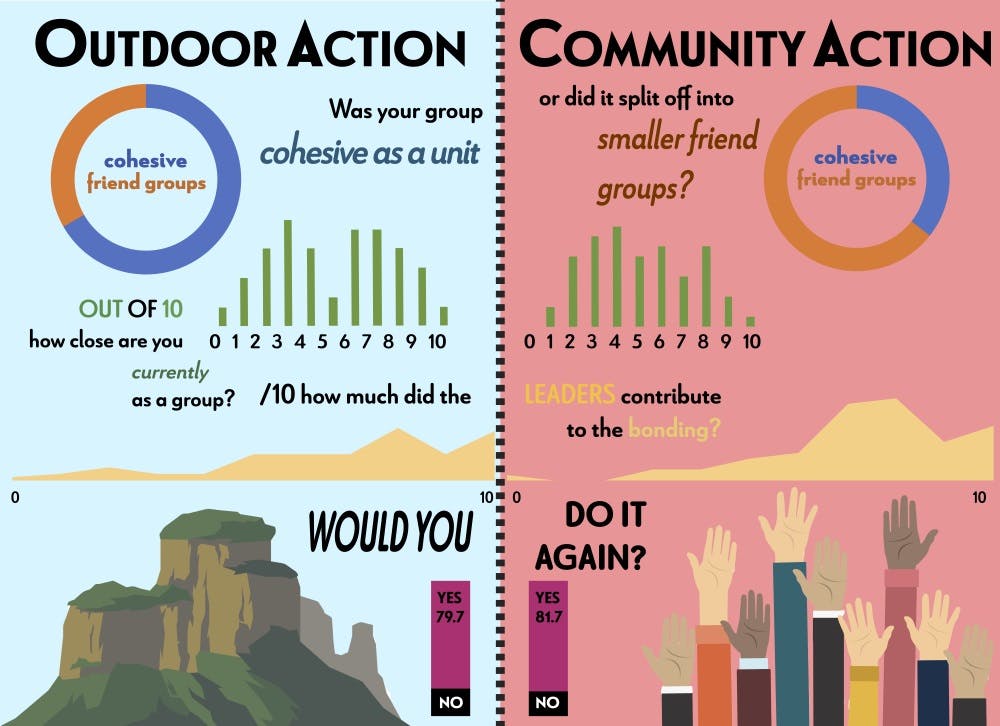The University’s first-year orientation programs are touted to prospective students as a way to “allow students to form strong bonds among first-years across residential colleges and with their student trip leaders across class years.” The degree to which students actually enjoy this prototypical experience, though, varies based on the program they’re assigned to.
A voluntary survey conducted by The Daily Princetonian of 133 University first-years revealed key differences in the experiences of respondents on Outdoor Action and Community Action trips. Out of the survey respondents, 73 participated in Outdoor Action and 60 participated in Community Action.
Respondents perceived that Outdoor Action fosters a stronger bonding experience between orientation group members. 85 percent of those surveyed, regardless of their placement on either OA or CA, felt that OA was more conducive to group cohesion.
“OA was literal hell during the trip, but afterwards I am extremely glad I went. I’d do it again in a heartbeat,” commented Noah Schochet ’21. “It’s one of those ‘what doesn’t kill you makes you stronger’ situations.”
Two-thirds of respondents who participated in OA said that their orientation group was cohesive as a unit, and not ‘clique-y’ or divided into smaller groups. In contrast, only 36 percent of the CA respondents said their group was cohesive.
In their written responses to the survey, some respondents suggested that the lesser degrees of connection between CA groups could be the result of cell phone use being permitted on the trip.
Taylor Mills ’20, a CA leader, said that the program fosters small-group friendships in a different way than OA — while participants aren’t bonding over hardships like a lack of showers and physically challenging hikes, they do have more time to talk and build relationships by working together.
“CA does cultivate smaller-group friendships, which gives people the chance to get to know others in a service context,” Mills said. “Doing service together really helps people bond because you have to be vulnerable.”

CA participants expressed a similar view.
“During our CA trip, all of us were so willing to be vulnerable with one another and honest about ourselves that we can now be 100 percent there for each other,” said CA participant Chantal Thantrong ’21.
However, average responses of OA and CA participants indicated that their orientation groups are similarly close now, even two months after the experience. On a scale from 0 to 10, where 0 was extremely distant and 10 was extremely close, respondents rated their current closeness with their groups 4.94 for OA and 4.96 for CA.
A majority of students on both kinds of orientation trips reported willingness to repeat their experience: 79.7 percent of OA respondents said they would go on their trip again, and 81.7 percent of CA participants said the same.

In their written responses to the survey, students highlighted the unique conditions under which the trip was conducted — with a group of strangers only two days after arriving at college — as a conduit for friendship and a social experience that helped them overcome potential awkwardness when trying to make friends on campus.
“I loved how my OA trip brought people together from such wildly different backgrounds in a shared experience — it really set a good tone for the start of Princeton and I really appreciate all of the friendships I made on that trip and have carried on throughout the semester,” wrote Amanda Eisenhour ’21.
Survey respondents also emphasized the ease their trips afforded them in adjusting to the social scene at the University.
“My OA trip was an amazing experience that served as the foundation for my successful transition to college life. In fact, I made many of my closest friends on the trip,” wrote Alex Taylor-Lash ’21.
Respondents to the ‘Prince’ survey also suggested that the generally high quality of leadership —
rated by respondents an average 7.41/10 for CA and 6.99 for OA — contributed positively to their orientation experiences.
“Towards the end [of] OA my leader said that the trip made him fall back in love with Princeton. As someone who had a very hard time deciding what school to attend, the trip made me fall in love with Princeton for the first time,” Zachary Holecek ’21 said, adding that his OA leader was “phenomenal.”
Leader training for next year’s orientation trips began for OA over fall break, and will continue through the spring. Leader applications for CA have not yet been released; last year they were due on Feb. 5.








